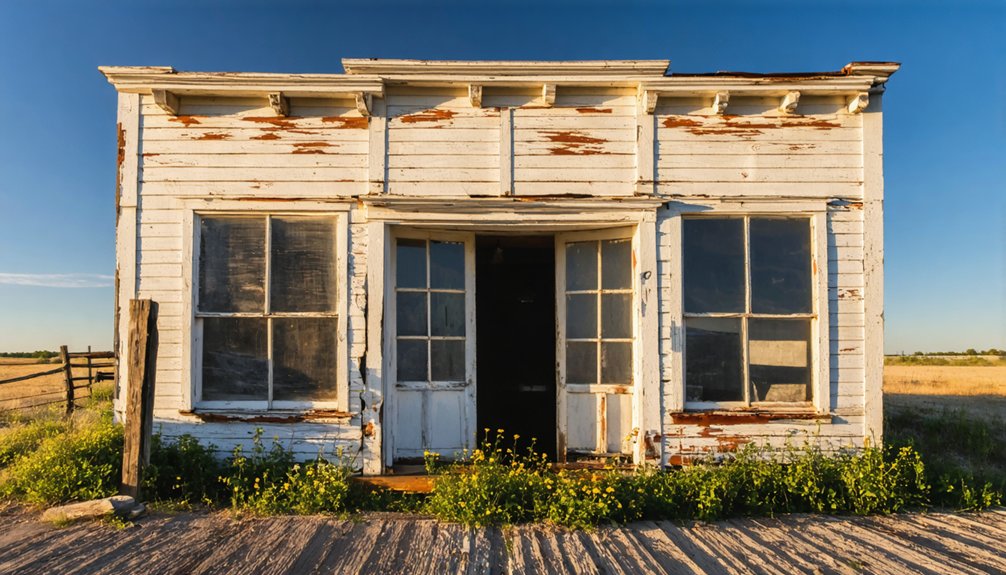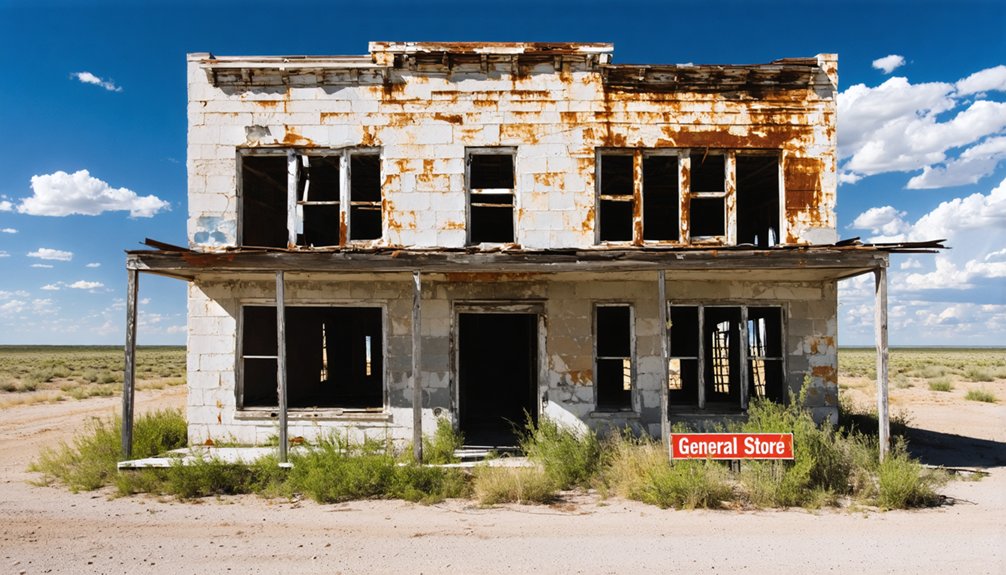You’ll find Frosa’s weathered ruins at the historic Presidio Crossing on the Frio River, where this frontier town flourished in the 1870s. Founded in 1871 as Frio City, it grew to 1,500 residents and served as a crucial administrative center with the region’s first courthouse and stone jail. Like many rural Texas communities, Frosa declined when bypassed by major transportation routes. Today, its abandoned structures tell a compelling story of boom-and-bust frontier settlement.
Key Takeaways
- Founded in 1871 near Presidio Crossing on the Frio River, Frosa was a thriving administrative center with 1,500 residents by 1880s.
- The town’s decline began when it was bypassed by major transportation routes, similar to neighboring communities in rural Texas.
- Economic hardships intensified during the Dust Bowl, leading to rural depopulation and closure of local businesses and schools.
- Historic structures remain as testament to frontier settlement, though preservation faces challenges from decay and complex regulations.
- Current remnants showcase Texas frontier architecture, attracting heritage tourism interest despite limited infrastructure and sparse population.
Historical Origins and Settlement
Three key developments marked the founding of Frosa, initially known as Frio City, in 1871.
First, you’ll find its strategic location at the Presidio Crossing on the Frio River, which served as a crucial route for settlers and ranchers. Similar to Plemons Crossing, the location was chosen for its safe river passage.
The historic Presidio Crossing on the Frio River became a vital pathway where pioneers forged new frontiers and opportunities.
Second, the town’s establishment as a regional administrative center shaped early settlement patterns, anchored by the county’s first courthouse and stone jail built in 1872.
Third, you’ll discover how the community’s organization quickly attracted a diverse population seeking opportunities in this frontier hub. The town experienced rapid growth, reaching 1,500 residents by the 1880s.
Transportation’s Role in Town Development
While Frosa’s initial growth centered around its strategic river crossing, the town’s long-term fate hinged on shifting transportation patterns across Texas.
Today, visitors can explore 511 ghost towns scattered across the state that share similar stories of transportation-related decline.
You’ll find that the transportation evolution from river crossings to railroads dramatically shaped the region’s development, with towns either thriving or fading based on their rail connections.
The economic impact of being bypassed by major transportation routes proved devastating for communities like Frosa.
Just as neighboring Plemons lost its prominence when the railroad chose Stinnett instead, many Texas towns faced similar fates.
Similar to Glen Rio’s decline after the Route 66 closure, communities without adaptable transportation infrastructure struggled to maintain their populations.
Whether it was missing out on rail service or later being bypassed by highways, transportation access became the lifeline that determined a town’s survival.
Without strong transportation links, Frosa couldn’t sustain the economic diversification needed to weather changing times.
The Era of Economic Decline
The economic decline of Frosa paralleled broader struggles facing rural Texas communities during the mid-twentieth century. You’d have witnessed the town’s gradual economic stagnation as agricultural mechanization reduced the need for farm workers, triggering the first wave of rural depopulation. The devastating effects of the Dust Bowl only accelerated this decline. Like many single-industry communities, Frosa’s dependence on agriculture left it vulnerable to economic collapse.
- Farm families abandoned their properties as drought conditions made agriculture increasingly unsustainable.
- Young residents left for urban areas offering more diverse job opportunities.
- Local businesses shuttered as the customer base dwindled.
- Schools and essential services closed, making it harder for remaining residents to stay.
Without economic diversification to cushion against agricultural downturns, Frosa couldn’t sustain its population. Similar to modern Texas where 75 counties lost population in just one year, the town’s fate was sealed as each departure weakened the community’s economic foundation until only empty buildings remained.
Remnants and Architectural Heritage
Standing among Frosa’s architectural remnants today, you’ll find a stark tribute to frontier settlement construction, with locally sourced materials defining what’s left of this once-vibrant community.
The architectural significance of these weathered structures lies in their utilitarian design and period craftsmanship, evident in the remaining brickwork, wooden beams, and stone foundations. Similar to other communities affected by railroad rerouting, Frosa’s structures stand as testament to economic forces that shaped Texas towns. Much like El Castille with its eighteen fireplaces, these buildings showcase the ambitious architectural vision of early Texas settlers.
You can trace the community identity through the scattered ruins, which reveal a traditional town layout with a central gathering area.
While environmental forces continue to erode these historical treasures, local preservation groups work to protect what remains.
Archaeological artifacts discovered among the foundations tell stories of daily life, and though Frosa’s remnants may be more fragmentary than other Texas ghost towns, they’re essential pieces of regional heritage worth preserving.
Life in Modern-Day Frosa
Today’s Frosa presents a stark portrait of rural decline, where aging structures and sparse population reflect broader demographic shifts across West Texas.
You’ll find a community that’s weathered significant changes, with many residents relocating to urban centers like Dallas-Fort Worth, leaving behind a largely aging population. Like many of the 511 ghost towns scattered throughout Texas, Frosa exemplifies the challenges of preserving historical communities.
- Community engagement now centers around small-scale gatherings, with most social activities consolidated in neighboring towns.
- You’ll notice limited infrastructure maintenance, with aging roads and unreliable internet connectivity.
- Local businesses have largely shuttered, forcing residents to travel elsewhere for basic services.
- Housing mostly consists of older structures, with vacant properties and minimal new construction marking the landscape. Rising property tax burdens continue to drive out remaining homeowners.
Those who remain maintain deep ties to their heritage, though they face increasing isolation and reduced access to essential services.
Local Legends and Cultural Legacy
Deep within the fading structures of Frosa lies a rich tapestry of supernatural folklore that’s uniquely woven from Native American beliefs, settler experiences, and historical tragedies.
You’ll hear tales of mysterious voices that lure wanderers into the wilderness and accounts of supernatural encounters with hybrid creatures bearing bird-like bodies and human faces.
Local folk narratives speak of witches and cursed women, serving as cautionary tales to keep you away from dangerous areas after dark.
These stories often trace back to real historical events – violent conflicts, natural disasters, and economic hardships that shaped the town’s destiny.
The abandoned buildings, particularly old homes and funeral houses, have become focal points for ghost stories, with reports of spectral figures walking balconies and unexplained phenomena that continue to intrigue visitors and preserve Frosa’s haunting legacy.
Preservation Efforts and Future Outlook

While supernatural tales capture imaginations, the physical preservation of Frosa faces real-world challenges that’ll determine its survival.
Like many Texas ghost towns, it confronts preservation challenges including unclear property titles, strict zoning laws, and the constant threat of structural decay.
Preserving Texas ghost towns requires navigating legal hurdles and battling time as buildings slowly crumble into history.
You’ll find community involvement is essential for protecting this piece of Texas heritage, as local advocacy can help secure funding and prevent demolition of historically significant structures.
- You’re looking at significant restoration costs due to the absence of basic utilities
- You’ll need to navigate complex permits and regulations for any preservation work
- You can help by supporting local preservation groups working to document the site
- You’ll see that successful preservation could transform Frosa into a heritage tourism destination
Frequently Asked Questions
What Is the Closest Major City or Town to Frosa Today?
You’ll find Groesbeck, Texas is the closest operational town to Frosa today, lying about 14 miles southeast. When exploring Frosa’s history and nearby attractions, Groesbeck serves as your main access point.
Are There Any Annual Events or Festivals Still Held in Frosa?
You won’t find any annual events or festivals in Frosa today. Despite Texas’s rich ghost town tourism scene, this forgotten settlement hasn’t maintained any regular gatherings as part of its history.
Can Visitors Legally Explore the Remaining Structures in Frosa?
You can’t legally explore any structures in Frosa since there aren’t documented remains, and any potential historic remnants would be on private property requiring owner permission for exploration or preservation activities.
What Was the Peak Population of Frosa During Its Most Prosperous Years?
Like many railroad boomtowns of the Roaring Twenties, you’ll find Frosa’s history peaked in 1920 with 913 residents, though recent Frosa economy estimates suggest you might see numbers approaching 971 today.
Are There Any Descendants of Original Frosa Residents Still Living Nearby?
While there’s no documented proof of direct family connections in the area today, historical preservation records suggest descendants of Frosa’s original settlers might live in surrounding Limestone County communities.
References
- https://www.county.org/county-magazine-articles/summer-2025/ghost-towns
- https://www.hipcamp.com/journal/camping/texas-ghost-towns/
- https://texashighways.com/travel-news/four-texas-ghost-towns/
- https://www.youtube.com/watch?v=phjUE19A8HM
- https://jamesbigleyranches.com/general/texas-ghost-towns/
- https://cedarbayoumarina.com/four-ghost-towns-under-lake-texoma/
- https://en.wikipedia.org/wiki/List_of_ghost_towns_in_Texas
- https://www.ghosttowns.com/states/tx/frosa.html
- https://www.texasescapes.com/CentralTexasTownsNorth/Marysville-Texas.htm
- https://www.youtube.com/watch?v=Ux4FjzHs5DE



